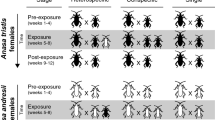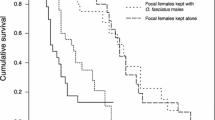Abstract
Although studies classify the polygynous mating system of a given species into female defense polygyny (FDP) or resource defense polygyny (RDP), the boundary between these two categories is often slight. Males of some species may even shift between these two types of polygyny in response to temporal variation in social and environmental conditions. Here, we examine the mating system of the Neotropical harvestman Acutisoma proximum and, in order to assess if mate acquisition in males corresponds to FDP or RDP, we tested four contrasting predictions derived from the mating system theory. At the beginning of the reproductive season, males fight with other males for the possession of territories on the vegetation where females will later oviposit, as expected in RDP. Females present a marked preference for specific host plant species, and males establish their territories in areas where these host plants are specially abundant, which is also expected in RDP. Later in the reproductive season, males reduce their patrolling activity and focus on defending individual females that are ovipositing inside their territories, as what occurs in FDP. This is the first described case of an arachnid that exhibits a shift in mating system over the reproductive season, revealing that we should be cautious when defining the mating system of a species based on few observations concentrated in a brief period.




Similar content being viewed by others
References
Alcock J, Houston TF (1996) Mating systems and male size in Australian hylaeine bees (Hymenoptera: Colletidae). Ethology 102:591–610
Alcock J, Jones CE, Buchmann SL (1977) Male mating strategies in the bee Centris pallida Fox (Anthophoridae: Hymenoptera). Am Nat 111:145–155
Aluja M, Lozada N, Piñero J, Birke A, Hernández-Ortiz V, Díaz-Fleischer F (2001) Basic behavior of Rhagoletis turpiniae (Diptera: Tephritidae) with comparative notes on the sexual behavior of Rhagoletis pomonella and Rhagoletis zoqui. Ann Entomol Soc Am 94:268–274
Buzatto BA, Requena GS, Martins EG, Machado G (2007) Effects of maternal care on the lifetime reproductive success of females in a Neotropical harvestman. J Anim Ecol 76:937–945
Choe JC (1994) Sexual selection and mating system in Zorotypus gurneyi Choe (Insecta, Zoraptera) 1. Dominance hierarchy and mating success. Behav Ecol Sociobiol 34:87–93
Choe JC (1997) The evolution of mating systems in the Zoraptera: mating variations and sexual conflicts. In: Choe JC, Crespi BJ (eds) The evolution of mating systems in insects and arachnids. Cambridge University Press, Cambridge, pp 130–145
Cokendolpher JC, Mitov PG (2007) Natural enemies. In: Pinto-da-Rocha R, Machado G, Giribet G (eds) Harvestmen: the biology of Opiliones. Harvard University Press, Cambridge, pp 339–373
Crespi BJ (1988) Risks and benefits of lethal male fighting in the colonial, polygynous thrips Hoplothrips karnyi (Insecta, Thysanoptera). Behav Ecol Sociobiol 22:293–301
Curtis DJ, Machado G (2007) Ecology. In: Pinto-da-Rocha R, Machado G, Giribet G (eds) Harvestmen: the biology of Opiliones. Harvard University Press, Cambridge, pp 280–308
Darwin C (1871) The descent of man and selection in relation to sex. John Murray, London
Dimock Jr RV (1985) Population dynamics of Unionicola formosa (Acari: Unionicolidae), a water mite with a harem. Am Midl Nat 114:168–179
Eberhard WG (1975) The ecology and behavior of a subsocial pentatomid bug and two scelionid wasps: strategy and counterstrategy in a host and its parasites. Smithson Contrib Zool 205:1–39
Eberhard WG (1998) Sexual behavior of Acanthocephala declivis guatemalana (Hemiptera: Coreidae) and the allometric scaling of their modified hind legs. Ann Entomol Soc Am 91:863–871
Emlen ST, Oring LW (1977) Ecology, sexual selection, and the evolution of mating systems. Science 197:215–223
Fujisaki K (1981) Studies on the mating system of the winter cherry bug, Acanthocoris sordidus Thunberg (Heteroptera: Coreidae) II. Harem defence polygyny. Res Popul Ecol 23:232–279
Gnaspini P (1995) Reproduction and postembryonic development of Goniosoma spelaeum, a cavernicolous harvestman from southeastern Brazil (Arachnida: Opiliones: Gonyleptidae). Invertebr Reprod Dev 28:137–151
Gnaspini P, Hara MR (2007) Defense mechanisms. In: Pinto-da-Rocha R, Machado G, Giribet G (eds) Harvestmen: the biology of Opiliones. Harvard University Press, Cambridge, pp 347–399
Greenfield MD (1997) Sexual selection in resource defense polygyny: lessons from territorial grasshoppers. In: Choe JC, Crespi BJ (eds) The evolution of mating systems in insects and arachnids. Cambridge University Press, Cambridge, pp 75–88
Groddeck J, Mauss V, Reinhold K (2004) The resource-based mating system of the Mediterranean pollen wasp Ceramius fonscolombei Latreille 1810 (Hymenoptera, Vespidae, Masarinae). J Insect Behav 17:397–418
Gwynne DT (1980) Female defense polygyny in the bumblebee wolf, Philanthus bicinctus. Behav Ecol Sociobiol 7:213–225
Gwynne DT, Morris GK (1983) Orthopteran mating systems: sexual competition in a diverse group of insects. Westview, Boulder
Hamilton WJ III, Buskirk RE, Buskirk WH (1976) Social organization of the Namib Desert tenebrionid beetle Onymacris rugatipennis. Can Entomol 108:305–316
Hastings JM, Dodson GN, Heckman JL (1994) Male perch selection and the mating system of the robber fly, Promachus albifacies (Diptera: Asilidae). J Insect Behav 7:829–841
Kelly CD (2008) The interrelationships between resource holding potential, resource-value and reproductive success in territorial males: how much variation can we explain? Behav Ecol Sociobiol 62:855–871
Kirkendall LR (1983) The evolution of mating systems in bark and ambrosia beetles (Coleoptera: Scolytidae and Platypodidae). Zool J Linn Soc 77:293–352
Kirkendall LR, Kent DS, Raffa KA (1997) Interactions among males, females and offspring in bark and ambrosia beetles: the significance of living in tunnels for the evolution of social behavior. In: Choe JC, Crespi BJ (eds) The evolution of social behavior in insects and arachnids. Cambridge University Press, Cambridge, pp 181–215
Lloyd JE (1981) Sexual selection: individuality, identification, and recognition in a bumblebee and other insects. Fla Entomol 64:89–123
Machado G, Oliveira PS (1998) Reproductive biology of the Neotropical harvestman (Goniosoma longipes) (Arachnida, Opiliones: Gonyleptidae): mating and oviposition behaviour, brood mortality, and parental care. J Zool 246:359–367
Machado G, Oliveira PS (2002) Maternal care in the Neotropical harvestman Bourguyia albiornata (Arachnida: Opiliones): oviposition site selection and egg protection. Behaviour 139:1509–1524
Macías-Ordóñez R (1997) The mating system of Leiobunum vittatum Say 1821 (Arachnida: Opiliones: Palpatores): resource defense polygyny in the striped harvestman. PhD thesis, Lehigh University, USA, pp 167
Macías-Ordóñez R (2000) Touchy harvestmen. Nat Hist 109:58–61
Martin P, Bateson P (1986) Measuring behaviour: an introductory guide. Cambridge University Press, New York
McCurdy DG, Boates JS, Forbes MR (2000) Reproductive synchrony in the intertidal amphipod Corophium volutator. Oikos 88:301–308
Mitchell PL (1980) Combat and territorial defense of Acanthocephala femorata (Hemiptera, Coreidae). Ann Entomol Soc Am 73:404–408
Mora G (1990) Parental care in a Neotropical harvestman, Zygopachylus albomarginis (Arachnida, Opiliones: Gonyleptidae). Anim Behav 39:582–593
Osses F, Martins EG, Machado G (2008) Oviposition site selection by the Neotropical bromeliad-dweller harvestman Bourguyia hamata (Arachnida: Opiliones). J Ethol 26:233–241
Ostfeld RS (1987) On the distinction between female defense and resource defense polygyny. Oikos 48:238–240
Poston JP (1997) Dominance, access to colonies, and queues for mating opportunities by male boat-tailed grackles. Behav Ecol Sociobiol 41:89–98
Reid ML, Stamps JA (1997) Female mate choice tactics in a resource-based mating system: field tests of alternative models. Am Nat 150:98–121
Robinson SK (1986) Benefits, costs, and determinants of dominance in a polygynous oriole. Anim Behav 34:241–255
Saito Y (1990) Factors determining harem ownership in a subsocial spider mite (Acari, Tetranychidae). J Ethol 8:37–43
Scott MP (1998) The ecology and behavior of burying beetles. Annu Rev Entomol 43:595–618
Shuster SM, Wade MJ (2003) Mating systems and strategies. Princeton University Press, Princeton
Smith AP, Alcock J (1980) A comparative-study of the mating systems of Australian eumenid wasps (Hymenoptera). Z Tierpsychol 53:41–60
Starks PT, Reeve HK (1999) Condition-based alternative reproductive tactics in the wool-carder bee, Anthidium manicatum. Ethol Ecol Evol 11:71–75
Suzuki S, Nagano M, Kobayashi N (2006) Mating competition and parentage assessment in Ptomascopus morio (Coleoptera: Silphidae): a case for resource defense polygyny. Eur J Entomol 103:751–755
Thomas RH, Zeh DW (1984) Sperm transfer and utilization strategies in arachnids: ecological and morphological constraints. In: Smith RL (ed) Sperm competition and the evolution of animal mating systems. Academic, London, pp 179–221
Thornhill R, Alcock J (1983) The evolution of insect mating systems. Harvard University Press, Cambridge
Webster MS (1994) Female-defence polygyny in a Neotropical bird, the Montezuma oropendola. Anim Behav 48:779–794
Webster MS, Robinson SK (1999) Courtship disruptions and male mating strategies: examples from female-defense mating systems. Am Nat 154:717–729
Wiley RH, Poston J (1996) Perspective: indirect mate choice, competition for mates, and coevolution of the sexes. Evolution 50:1371–1381
Wilkinson GS, Dodson GN (1997) Function and evolution of antlers and eye stalks in flies. In: Choe JC, Crespi BJ (eds) The evolution of mating systems in insects and arachnids. Cambridge University Press, Cambridge, pp 310–328
Willemart RH, Gnaspini P (2004) Breeding biology of the cavernicolous harvestman Goniosoma albiscriptum (Arachnida, Opiliones, Laniatores): sites of oviposition, egg-batches characteristics and subsocial behaviour. Invertebr Reprod Dev 45:15–28
Wolf LL, Waltz EC, Klockowski D, Wakeley K (1997) Influences on variation in territorial tenures of male white-faced dragonflies (Leucorrhinia intacta) (Odonata: Libellulidae). J Insect Behav 10:31–47
Acknowledgments
We are very grateful to the staff of Intervales State Park for logistical support, to T.M. Del Corso, N. Leiner, C.F. Lerche, P.M. Nassar, T.M. Nazareth, R.L. Paiva, and specially to G.S. Requena for helping with the fieldwork, to M. Almeida-Neto, S. Koehler, and L.D. Meirelles for the identification of host plant species, and to Drs. John Alcock, Carlos Cordero, Marcelo O. Gonzaga, Darryl Gwynne, and three anonymous reviewers who kindly provided useful comments on a previous version of the manuscript. The study was supported by fellowships from the Fundação de Amparo à Pesquisa do Estado de São Paulo (FAPESP, 02/00381-0 and 03/05427-0) and Coordenação de Aperfeiçoamento de Pessoal de Nível Superior (CAPES).
Author information
Authors and Affiliations
Corresponding author
Additional information
Communicated by D. Gwynne
Electronic supplementary material
Below is the link to the electronic supplementary material.
Electronic Supplemental Material S1
(DOC 59.5 KB)
Fig. S2
Relationship among resource value (RV, measured as the ITQ of males’ territories), male resource holding potential (RHP, measured as the length of the males’ sexually dimorphic leg II), and male reproductive success (RS, indirectly measured as the number of egg-guarding females inside males’ harems) in the harvestman Acutisoma proximum. (a) RHP vs. RS (r = 0.64; n = 15; P = 0.010); (b) RHP vs. RV (r = -0.276; n = 15; P = 0.320); (c) RV vs. RS (r = -0.198; n = 15; P = 0.479). For comparative purposes, see Table 4 from Kelly (2008), which provides effect sizes (r) for 22 animal species in which these three relationships have been investigated.
Rights and permissions
About this article
Cite this article
Buzatto, B.A., Machado, G. Resource defense polygyny shifts to female defense polygyny over the course of the reproductive season of a Neotropical harvestman. Behav Ecol Sociobiol 63, 85–94 (2008). https://doi.org/10.1007/s00265-008-0638-9
Received:
Revised:
Accepted:
Published:
Issue Date:
DOI: https://doi.org/10.1007/s00265-008-0638-9




